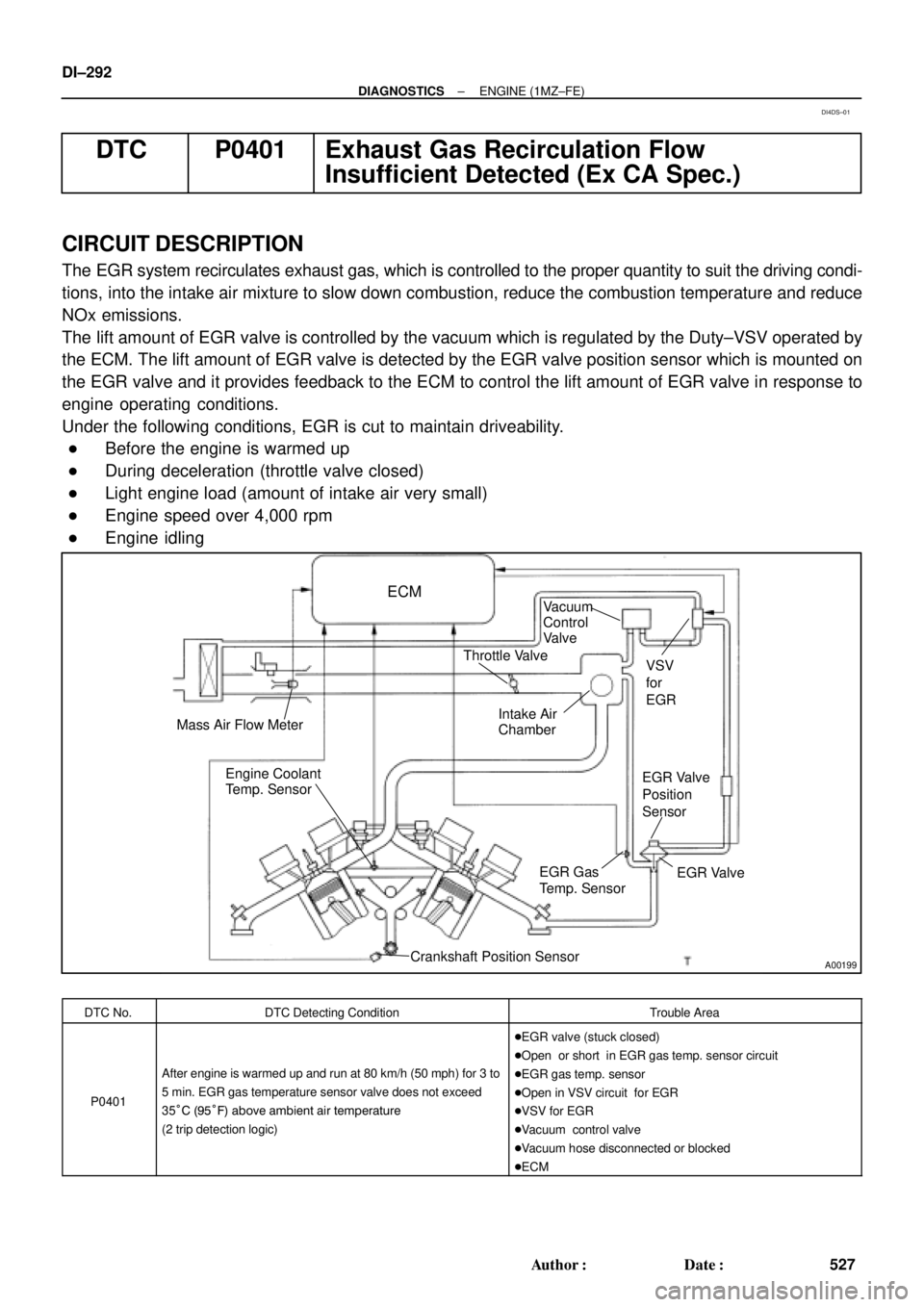Page 2640 of 4770

DI±220
± DIAGNOSTICSENGINE (1MZ±FE)
455 Author�: Date�:
Symbols (Terminals No.)Wiring ColorConditionSTD Voltage (V)
TC (E11 ± 6) ± E1 (E10 ± 17)L±W eBRIG switch ON9 ~ 14
W (E7 ± 6) ± E01 (E11 ± 21)G±R eBRIG switch ONBelow 3.0
PS (E10 ± 9) ± E1 (E10 ± 17)B±L eBRIG switch ON9 ~ 14
ACT (E8 13) E1 (E10 17)LG BBRA/C switch OFFBelow 2.0ACT (E8 ± 13) ± E1 (E10 ± 17)LG±B eBRA/C switch ON at idling9 ~ 14
A/C (E8 25) E1 (E10 17)BYBRA/C switch ON at idlingBelow 2.0A/C (E8 ± 25) ± E1 (E10 ± 17)B±Y eBRA/C switch OFF9 ~ 14
CF (E11 29) E1 (E10 17)GWBRElectric cooling fan is operating on high speed9 ~ 14CF (E11 ± 29) ± E1 (E10 ± 17)G±W eBRElectric cooling fan is operating on low speed or OFF0 ~ 2
TACH (E8± 27) ± E1 (E10 ± 17)B±O eBRIdlingPulse generation
TPC (E7 ± 9) ± E01 (E11 ± 21)W±R eBRIG switch ON
Disconnect the vacuum hose from the vapor pressure sensor9 ~ 14
PTNK (E7 17)IG switch ON3.0 ~ 3.6PTNK (E7 ± 17)
± E1 (E10 ± 17)L±R eBRIG switch ON
Apply vacuum 2.0 kPa (15 mmHg, 0.6 in.Hg)1.3 ~ 2.1
SIL (E7 ± 11) ± E1 (E10 ± 17)W eBRDuring transmissionPulse generation
STP (E7 15) E1 (E10 17)GWBR
IG switch ON
Brake pedal depressed7.5 ~ 14
STP (E7 ± 15) ± E1 (E10 ± 17)G±W eBRIG switch ON
Brake pedal releasedBelow 1.5
EGLS (E11 ± 22)WGBR
IG switch ON
Apply vacuum (0 kPa, 0 mmHg, 0 in.Hg) to EGR valve0.4 ~ 1.6EGLS (E11 22)
± E1 (E10 ± 17)W±G eBRIG switch ON
Apply vacuum (17.3 kPa, 130 mmHg, 5.12 in.Hg) to EGR valve3.2 ~ 5.1
*1
AFR+ (E10 ± 11
± E1 (E10 ± 17)BR eBRIG switch ON3.3*
*1
AFR± (E10 ± 20)
± E1 (E10 ± 17)B±R eBRIG switch ON3.0*
*1
AFL+ (E10 ± 12)
± E1 (E10 ± 17)B±W eBRIG switch ON3.3*
*1
AFL± (E10 ± 21)
± E1 (E10 ± 17)L eBRIG switch ON3.0*
*1
HAFR (E10 ± 3)BRBRIG switch ONBelow 3.0 HAFR (E10 3)
± E04 (E10 ± 1)B±R eBRIdling (warm up the engine)Pulse generation
*1
HAFL (E10 ± 4)BWBRIG switch ONBelow 3.0 HAFL (E10 4)
± E05 (E10 ± 8)B±W eBRIdling (warm up the engine)Pulse generation
KSW (E8 11) E1 (E10 17)LBBRAt time of inserting the keyBelow 1.5KSW (E8 ± 11) ± E1 (E10 ± 17)L±B eBRIn condition without the key inserted4 ~ 5
RXCK (E9 ± 5) ± E1 (E10 ± 17)R±L eBRAt time of inserting the keyPulse generation
CODE (E9 ± 4) ± E1 (E10 ± 17)G±W eBRAt time of inserting the keyPulse generation
IGSW (E7 ± 2) ± E1 (E10 ± 17)B±R eBRIG switch ON9 ~ 14
TXCT (E9± 10) ± E1 (E10 ± 17)L±Y eBRAt time of inserting the keyPulse
IMLD (E9 ± 16) ± E1 (E10 ± 17)R±Y eBRIn condition without the key insertedPulse
MREL (E7 ± 8) ± E1 (E10 ± 17)B±R eBRIG switch ON9 ~ 14
*: The ECM terminal voltage is fixed regardless of the output voltage from the sensor.
*
1: Only for California specification vehicles
Page 2698 of 4770

DI±278
± DIAGNOSTICSENGINE (1MZ±FE)
513 Author�: Date�:
INSPECTION PROCEDURE
HINT:
�If is the case that DTC besides misfire is memorized simultaneously, first perform the troubleshooting
for them.
�Read freeze frame data using TOYOTA hand±held tester or OBD II scan tool. Because freeze frame
data records the engine conditions when the malfunction is detected, when troubleshooting it is useful
for determining whether the vehicle was running or stopped, the engine warmed up or not, the air±fuel
ratio lean or rich, etc. at the time of the malfunction.
�When the vehicle is brought to the workshop and the misfire is not occurred, misfire can be confirmed
by reproducing the condition or freeze frame data. Also, after finishing the repair, confirm that there
is no misfire. (See the confirmation driving pattern)
�When either of SHORT FT #1, LONG FT #1, SHORT FT #2 or LONG FT #2 in the freeze frame data
is besides the range of ±20%, there is a possibility that the air±fuel ratio is inclining either to ºrichº
(±20% or less) or ºleanº (+20% or more).
�When COOLANT TEMP in the freeze frame data is less than 80°C (176°F), there is a possibility or
misfire only during warming up.
�In the case that misfire cannot be reproduced, the reason may be because of the driving with lack or
fuel, the use of improper fuel, a stain of ignition plug, and etc.
1 Check wire harness, connector and vacuum hose in engine room.
CHECK:
(a) Check the connection conditions of wire harness and connector.
(b) Check the disconnection, piping and break of vacuum hose.
NG Repair or replace, then confirm that there is no
misfire (See the confirmation driving pattern).
OK
Page 2712 of 4770

A00199
ECM
Mass Air Flow MeterVSV
for
EGR
EGR Valve
Position
Sensor
EGR Valve EGR Gas
Temp. Sensor
Crankshaft Position Sensor Engine Coolant
Temp. SensorIntake Air
Chamber Throttle ValveVacuum
Control
Valve
DI±292
± DIAGNOSTICSENGINE (1MZ±FE)
527 Author�: Date�:
DTC P0401 Exhaust Gas Recirculation Flow
Insufficient Detected (Ex CA Spec.)
CIRCUIT DESCRIPTION
The EGR system recirculates exhaust gas, which is controlled to the proper quantity to suit the driving condi-
tions, into the intake air mixture to slow down combustion, reduce the combustion temperature and reduce
NOx emissions.
The lift amount of EGR valve is controlled by the vacuum which is regulated by the Duty±VSV operated by
the ECM. The lift amount of EGR valve is detected by the EGR valve position sensor which is mounted on
the EGR valve and it provides feedback to the ECM to control the lift amount of EGR valve in response to
engine operating conditions.
Under the following conditions, EGR is cut to maintain driveability.
�Before the engine is warmed up
�During deceleration (throttle valve closed)
�Light engine load (amount of intake air very small)
�Engine speed over 4,000 rpm
�Engine idling
DTC No.DTC Detecting ConditionTrouble Area
P0401
After engine is warmed up and run at 80 km/h (50 mph) for 3 to
5 min. EGR gas temperature sensor valve does not exceed
35°C (95°F) above ambient air temperature
(2 trip detection logic)
�EGR valve (stuck closed)
�Open or short in EGR gas temp. sensor circuit
�EGR gas temp. sensor
�Open in VSV circuit for EGR
�VSV for EGR
�Vacuum control valve
�Vacuum hose disconnected or blocked
�ECM
DI4DS±01
Page 2717 of 4770
A02507BE6653
A02839
ON
Air
E
GAir
G
FFE VSV is ON VSV is OFF
± DIAGNOSTICSENGINE (1MZ±FE)
DI±297
532 Author�: Date�:
4 Check connection and blockage of vacuum hose (See page EC±2).
NG Repair or replace vacuum hose.
OK
5 Check VSV for EGR.
PREPARATION:
Select the ACTIVE TEST mode on the TOYOTA hand±held
tester.
CHECK:
Check operation VSV, when it is operated by the TOYOTA
hand±held tester.
OK:
VSV is ON:
Air from pipe E is flowing out through pipe F and G.
VSV is OFF:
Air from pipe E is flowing out through pipe G.
OK Go to step 8.
NG
6 Check operation of VSV for EGR (See page SF±56).
NG Replace VSV for EGR.
OK
Check for open in harness and connector
between engine room J/B and ECM.
Page 2718 of 4770
S05410
Vacuum
EGR Valve
DI±298
± DIAGNOSTICSENGINE (1MZ±FE)
533 Author�: Date�:
7 Check EGR system (See page EC±11).
NG Repair or replace.
OK
8 Check EGR valve.
PREPARATION:
(a) Disconnect the vacuum hose from EGR valve.
(b) Start the engine.
CHECK:
Check whether the engine stall when apply vacuum to EGR
valve.
OK:
Engine runs rough or stall.
NG Repair or replace EGR valve.
OK
9 Check vacuum control valve (See page EC±11).
NG Replace vacuum control valve.
OK
Check and replace ECM (See page IN±31).
Page 2719 of 4770
P23871
EGR Gas Temp. Sensor
Connector
± DIAGNOSTICSENGINE (1MZ±FE)
DI±299
534 Author�: Date�:
OBDII scan tool (excluding TOYOTA hand±held tester)
1 Check resistance of EGR gas temp. sensor.
PREPARATION:
Disconnect the EGR gas temp. sensor connector.
CHECK:
Measure resistance between terminals of the EGR gas temp.
sensor connector.
OK:
Resistance: 2.5 kW ~ 600 kW
(Not immediately after driving)
HINT:
If there is open circuit, ohmmeter indicates 720 kW or more.
If there is short circuit, ohmmeter indicates 200 W or less.
NG Replace EGR gas temp. sensor.
OK
2 Check for open and short in harness and connector between EGR gas temp.
sensor and ECM (See page IN±31).
NG Repair or replace harness or connector.
OK
3 Check connection and blockage of vacuum hose (See page EC±2).
NG Repair or replace vacuum hose.
OK
Page 2721 of 4770
S05410
Vacuum
EGR Valve
± DIAGNOSTICSENGINE (1MZ±FE)
DI±301
536 Author�: Date�:
7 Check EGR valve.
PREPARATION:
(a) Disconnect the vacuum hose from EGR valve.
(b) Start the engine.
CHECK:
Check whether the engine stall when apply vacuum to EGR
valve.
OK:
Engine runs rough or stall.
NG Repair or replace EGR valve.
OK
8 Check vacuum control valve (See page EC±11).
NG Replace vacuum control valve.
OK
Check and replace ECM (See page IN±31).
Page 2722 of 4770

DI±302
± DIAGNOSTICSENGINE (1MZ±FE)
537 Author�: Date�:
DTC P0402 Exhaust Gas Recirculation Flow
Excessive Detected (Ex CA Spec.)
CIRCUIT DESCRIPTION
Refer to DTC P0401 (Exhaust Gas Recirculation Flow Insufficient Detected) on page DI±292.
DTC No.DTC Detecting ConditionTrouble Area
P0402
When EGR cut±off, lift amount of EGR valve is
2.6 mm (0.1 in.) or more
(2 trip detection logic)
�EGR valve stuck open
�VSV for EGR open malfunction
�Short in VSV circuit for EGR
�Open or short in EGR valve position sensor circuit
�EGR valve position sensor
�ECM
See DTC P0401 (Exhaust Gas Recirculation Flow Insufficient Detected) on See page DI±292 for SYS-
TEM CHECK DRIVING PATTERN and WIRING DIAGRAM.
INSPECTION PROCEDURE
HINT:
Read freeze frame data using TOYOTA hand±held tester or OBD II scan tool. Because freeze frame records
the engine conditions when the malfunction is detected, when troubleshooting it is useful for determining
whether the vehicle was running or stopped, the engine warmed up or not, the air±fuel ratio lean or rich, etc.
at the time of the malfunction.
TOYOTA hand±held tester
1 Check connection and blockage of vacuum hose.
NG Repair or replace vacuum hose.
OK
2 Check VSV for EGR (See page DI±292, step 5).
OK Go to step 4.
NG
DI07X±06